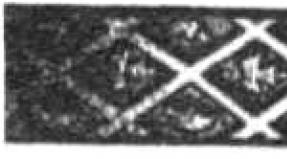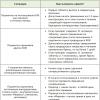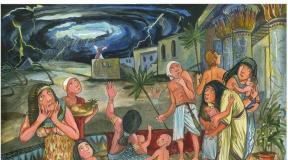Old maps of the Oryol province. Detailed map of the Oryol region with villages, cities, towns and districts Schubert's map of the Oryol province 1850
The Oryol province was formed in 1796 from the lands included in 1776 in the governorship of the same name. In turn, the Oryol vicegerency was formed in the territories previously allocated to the Oryol and Sevsk provinces (most of the land, the former jurisdiction of the Belgorod province), as well as the Livensky and Yelets districts (the former jurisdiction of the Voronezh province). In the future, the borders of the counties of the Oryol province changed several times. The last changes in the composition and boundaries of the counties of the Oryol province were made under Alexander the First, after which the boundaries of this province did not change for the entire subsequent period of the pre-revolutionary history of Russia.
The modern Orel region along its borders is greatly truncated compared to the pre-revolutionary Oryol province, and in fact represents only its central part.
In the Oryol province, in whole or in part
There are the following maps and sources:
(with the exception of those indicated on the main page of general
all-Russian atlases, where this province can also be)
 Survey map of the Oryol province
Survey map of the Oryol province
The survey map is a non-topographic (without indicating latitudes and longitudes), hand-drawn map of the late 18th century (after the borders were redistributed in 1775-78) on a scale of 1 inch = 2 versts 1 cm = 840 m or 1 inch = 1 verst 1 cm = 420 m. As a rule, the county was drawn on the parts that are shown on the composite sheet. Some of the maps belong to the period of Catherine II 1775-96, Paul I, having come to power, changed the borders of counties within the provinces (which, in turn, Alexander I returned to their original place, but with some changes), while part of the maps of the General Survey Fund survived only during this period.
 Lists of populated places in the Oryol province in 1871 (according to information from 1866)
Lists of populated places in the Oryol province in 1871 (according to information from 1866)
This is a universal reference book containing the following information:
- the status of the settlement (village, village, village - owner or state, i.e. state);
- the location of the settlement (in relation to the nearest tract, camp, at a well, pond, stream, river or river);
- the number of households in the settlement and its population (the number of men and women in the audit souls according to the 10th revision of 1858);
- distance from the county town and camp apartment (centre of camp) in versts;
- the presence of a church, a chapel, a mill, fairs, etc.
 Lists of populated places in the Oryol province in 1927.
Lists of populated places in the Oryol province in 1927.
Also a universal reference book containing the following information:
- the name of the locality;
- type of locality;
- the name of the nearest village council;
- location (on which river it stands, etc.);
- number of farms;
- the number of the present population as of December 17, 1926;
- distance from some points;
- availability of institutions, enterprises and organizations.
The information in the book is divided into districts of the Oryol province of that time.
In the European part of Russia there is one of the smallest subjects of the country - the Oryol region. Once upon a time, defensive fortresses were built on the lands of this region, which protected them from the raids of the Tatars. But centuries passed, the borders of Russia expanded and the border lines were built on other lands, and here arable farming and animal husbandry began to develop.
Satellite maps of the Oryol region will help you learn more about the region, consider its cities, roads, find any objects. This is a convenient and useful online service, both for residents of the region and for tourists coming to these parts. The maps show numerous villages that are of interest to those who like to travel and see the sights. Therefore, when going on a trip, each traveler will need maps of the Oryol region with diagrams to help.
The boundaries of the Oryol region limit the territories of neighboring regions:
- Kursk;
- Tula;
- Bryansk;
- Kaluga;
- Lipetsk.
Numerous rivers flow through the districts of the region, which are small and not navigable. The largest river is the Oka. Also on the map of the Oryol region with districts you will find the rivers:
- Pine;
- Svala;
- Nerussa;
- Zusha;
- Navlya.
The rivers are a favorite place for recreation of local residents and tourists; a large number of various fish are found here, which are also bred in natural and artificial reservoirs.
Districts on the map of the Oryol region
For territorial organization, the region is divided into 24 districts. Each district on the map of the Oryol region has borders, settlements and roads. Moving around the territory of the region, on the maps you will find railway stations, industrial enterprises, theaters, museums and other objects.
The largest district of the region is Orlovsky. More than 70 thousand people live in it. Industrial enterprises, cultural institutions and shopping centers are also concentrated here. On a detailed road map of the Oryol region, it can be seen that all the main roads pass through this area and its main city, Orel:
- R-119;
- R-120;
- R-92;
Railway tracks from different directions also converge in Orel. A railway line connecting Moscow with the Crimea passes through this city. You can also go from Orel to:
- Riga;
- Dmitriev-Lgovsky;
- Dace;
- Bryansk.
The smallest in terms of population Znamensky district. As a detailed map of the Oryol region shows, it is located in the northern part of the region. A native of this land is the leader of the Communist Party of the Russian Federation G. Zyuganov. Orlovshchina is generally famous for its well-known countrymen. In each district of the region there is evidence of the residence of a famous poet, artist, actor. Using the maps of the Oryol region with cities and villages, you can find the Turgenev estate-museum, the Sheremetevs' house. Yesenin and Bunin also lived here.
Map of the Oryol region with cities and villages
The capital of the region is Orel. About 330 thousand people live in it. The rest of the cities are very small, with a population of more than 10 thousand people, there are only a few settlements:
- Livny;
- Znamenka;
- Mtsensk;
- Bolkhov.
But even small towns and villages indicated on the map of the Oryol region with settlements have their own unique history and are of interest to tourists interested in architecture, architecture, literature and art.
In the village of Frolovka there is a unique source of St. Kuksha, to which thousands of pilgrims and people come every year to be healed of various diseases. And in the village of Mymrino there is an original monument of ancient architecture - the Church of the Kazan Icon of the Mother of God.
On the map of the Oryol region with villages, such sights as:
- monument to ancient settlements;
- Church of Demetrius of Thessalonica;
- Epiphany Cathedral;
- Military History Museum;
- Manor Kantemirov;
- Mtsensk Ladya.
Picturesque landscapes, a large number of rivers and historical monuments attract tourists to the Oryol region. In cities and villages, guests of the region can be accommodated in hotel complexes and recreation centers.
Economy and industry of the Oryol region
The economy of the region is represented by industrial enterprises and the agricultural sector. Yandex maps of the Oryol region will help you find enterprises. The main plants and factories are engaged in the field of:
- ferrous metallurgy;
- mechanical engineering;
- construction.
Significant in terms of production are enterprises producing food products. There are several flour mills in the region that produce flour and cereals.
A significant part of the Orel budget is filled by the agricultural sector. The former collective farms and state farms have been reorganized and are now part of the agro-industrial complex holdings. Pigs and birds are raised in the Oryol region. Of agricultural crops, the cultivation of beets is of great importance, which is processed into sugar by local enterprises.
There are several foreign factories in the region that produce building materials and carbonated drinks. Attracting investments has increased the number of jobs and reduced unemployment in the region.
This year, 2016 marks the 450th anniversary of the founding of the city of Orel.
The fortress city of Orel was not the most fortified outpost on the turbulent frontiers. For example, its fortifications were noticeably inferior to neighboring Mtsensk. Nevertheless, it was Oryol that, over time, became not only a county, but also a provincial city, and later - a regional center.
The modern administrative division of the Oryol region is represented by 24 administrative districts and 3 cities districts.
Administrative division of the Oryol province in the period from 1798 to the 1920s. consisted of 12 counties (Bryansk, Trubchevsky, Sevsky, Dmitrovsky, Karachevsky, Bolkhovsky, Mtsensk, Orlovsky, Kromskoy, Maloarkhangelsky, Livensky, Yeletsky). In the first two decades after the establishment of the Orel province (in 1778 - 1798), there was also the Deshkinsky district (then abolished), and in the south-west of the province at first there was no Dmitrovsky district, but there was Lugansk. Of course, territorially the Oryol province did not coincide with the modern Oryol region. The province did not include Novosilsky uyezd, but partly included the territory of several neighboring and not only neighboring regions (for example, even part of the Sumy region). Only the administrative border between the Oryol and Kursk regions looks for the most part successive in relation to the administrative border between the Oryol and Kursk provinces.
The configuration of the Oryol district of the Oryol province itself, of course, has little in common with the outlines of the modern Oryol district. It can be noted that the elongation of the county along the Rybnitsa valley is obviously the result of a sequence of land development inXVI - XVIIcenturies And so, the configuration of the Orlovsky district of the provincial period is partly successive in relation to its earlier outlines. Exactly the same can be said about the neighboring Mtsensk district, elongated in a similar way along the watershed between Optukha and Zusha.
But as for the provincial period of the existence of the Oryol district, those who wish can easily study it using Schubert's maps of the 1860s. and according to the General Survey Plans of the last quarterXVIIIcentury. PGMs are more detailed, more meaningful, but in places they are difficult to read, and they are not without spatial distortions. Schubert's maps are closer to modern topographic maps, but not as detailed as PGM. And in the most, most general terms, you can easily find a small-scale map of the Oryol vicegerency.
We will familiarize ourselves below with a cartographic display of the territory of the Oryol district, which is separated in time from the PGM by almost the same distance as the PGM of Catherine's time is separated from us.
No, you will not see the original maps of that time below. Cartographic materials before PGM - they are either small-scale or look not like a map, but rather like an outline. Therefore, the map presented below is, of course, modern, but it was compiled on the basis of a source related to 1595. And the map displays the territory of the Orlovsky district within the boundaries, which took place 421 years ago.
I will allow myself a small "lyrical" digression from the topic. In general, when compiling this map of the Oryol district of 1595, I flattered myself with the hope that in the end I would be able - no, not to get hold of, of course, on the result of work - but to financially compensate for the time spent on work. In reality, at the moment I don’t see any income for myself in this at all, but only the risks associated with additional expenses. Well, if so, let this card be just a kind of gift for the anniversary of the founding of the city. And those who wish to get a printed copy can download the map here and print it out on an A1 sheet on their own (scale 1: 150000).
I can also note that the work on the map for me was somewhat facilitated by the fact that the displayed territory coincides a lot with the landscape most familiar from cycling trips. Ie, and in this case, I can remember cycling with a kind word.
Below the map I will duplicate in text format the material “From the compiler” placed on the map. The material "Explanation of the origin of some toponyms ...", as well as alphabetical lists of settlements and surnames of landowners (not placed on the map for lack of space) will be given in the form of separate posts. The list of surnames can be useful (among other things) in that it can be used to correct the spelling of a surname if it is not legible on a compressed map file.
So the map:
From the compiler.
The city of Oryol was founded in 1566 as a fortress on the turbulent frontiers of the Muscovite state. Three decades later, through the efforts of the scribe Dementy Yakovlev and the clerk Leonty Sofonov, a document describing the villages of the Oryol district was created. The document, now better known as the "Scribal Book of the Oryol District 1594/95"
In 1595, the Orlovsky district was administratively subdivided into 5 camps. Taichuk camp was located exclusively on the right bank of the Oka, the rest - on the left (and only a small section of meadows opposite modern Zhukovka belonged to Kamensky camp). The borders between the left-bank camps passed mainly along the watersheds and only in some places - at the sources of the Mezenka, at the Muratovsky well, at Nepolodi, at Tsvetynia and at the Sorochizhsky well - arbitrarily.
The borders of the county itself followed clear natural landmarks only in the north, in some places they passed along the watersheds, often arbitrarily, and in the south there is no need to talk about the pronounced border of the county.
According to V. Nedelin, the city of Oryol at first after its foundation was settled by service people from Belyov, Mtsensk, Bolkhov, Novosil, Karachev. He also cites data on the arrival of servicemen from Krapivna in Oryol.
Perhaps there is no doubt that the main migration flow was directed to the Orlovsky district from the north. This is indirectly confirmed by theʹ greater development of the Kamensky Stan in comparison with others - moreʹ high density of settlements, a large number of households, a low proportion of nameless land holdings. Some of the names of the landowners of the county are associated with more northern places: Metsnyankin, Serpukhovitinov, Pronsky, Kolugin.
Part of the settlers arrived in the county from the western side. Perhaps not only from near Karachev. The surname Putivltsev indicates a connection with the southwestern outskirts of the state, and the surname Litvinov may even indicate people from the territory that was then under the rule of Lithuania.
In addition to these two, there was a third direction - from the Don. Among other landowners, 8 Don atamans are mentioned in the Scribal Book: Yolka Kostentinov/ich/ Shishkin, Ugrim Kostentinov/ich/ Mansurov, Ostafiy Petrov/ich/ Martynov, Mikita Ofonasiev/ich/ Sitting and Vasily Ofonasiev/ich/ Sidyachiy, Mikhail Vasiliev/ ich/ Okulov, Bezson Grigoriev/ich/ Likhotin, Bezson Fadeev/ich/ Talyshmanov. However, only 8 personalities out of 1938 landowners say that the resettlement flow from the Don was relatively small.
Theoretically, in an almost depopulated by the middleXVIcenturies, in the forest-steppe space of the “wild field” (but far from the paths of horse raids), tiny settlements could well have been lost. Such, albeit a very small population of “walking people”, with the expansion of the borders of the state, could also replenish the county.
In 1595, settlements and other land holdings were represented in the Oryol district in different ways. The city-fortress - Orel. There were 5 villages (Upper Mezin, Lower Mezin, Onakhino, Grigoryevskoye, Nikitskoye), a village - 1 (Mikulichi). Villages in all cases are located near churchyards. And it is not entirely clear: do the villages owe their status to the proximity of the churchyard or to the presence of the church in the village itself? It is also unclear why, out of the many settlements, one is designated specifically as a "village" - perhaps there was a chapel.
Most of the settlements in the county are listed as villages.
Small new settlements were called pochinkas. In general, there are fewer repairs than the village, but in particular, exceptions are not uncommon.
Formerly abandoned villages, repairs and borrowings are called wastelands in the Scribe Book.
And relatively recently, lands without residential buildings taken for arable land or for haymaking are indicated as loans.
The names of settlements are most often derived either from the full name of the owners, or from the features of the surrounding area. The value of the Scribe Book also lies in the fact that it was created at the time of the emergence of villages, and the text directly mentions the persons from whose full name the name of the village comes. It is noteworthy that some villages and villages have retained their names to the present day, while others have changed names over the years in accordance with the names of the landowners. It is curious in this connection that in many cases continuity was maintained despite, for example, the events of the Time of Troubles.
In the most general terms, the unnamed points are younger than the ones named after the patronymic, those are younger than the ones named after the surname. All of them are younger than the points named after the names, patronymics, and surnames of the former owners, who are no longer named in the Scribal Book. Oikonyms named according to the features of the area and hydronyms are probably older than those named according to the names of the owners. But all this is only in the most general terms. In reality, pochinok (even named after) may be older than a village named after a surname. The middle name of the owner in one record of the book may turn out to be a surname in another record (not only the formation of settlements, but also the formation of new surnames in the book is sometimes noticeable). And in the case, for example, with Bogdanovka, there is a controversial question, what first came from the surname - oikonym or hydronym?
When compiling the map, a punchson with an area of about 4 hectares was chosen to depict one yard (on the scale of the map). This value is close to the area of arable land of the average landowner, but five times less than his total land allotment. On average, of course. For example, Mitka Fedorov /ich / Kurapov had an order of magnitude less land than Ofonasei Klementiev /ich / Zhilin: and that one had 16 only arable land, a total of 243 four in two camps, including (no one else has such rights in the county there was!) even the river itself (the Oka from the mouth of the Itskaya to the upper reaches, the Krom from the Oka to the mouth of the Kremecha).
Peasant households were located on the lands of the landowner (if at the same time there were no households of the landowner himself in the village, then his land is not displayed in red punches on the map.
For these reasons, the area of the settlement on the map does not reflect the actual area of the settlement.
But on the other hand, it gives an approximate idea of the population in each settlement.
If we judge the dynamics of natural growth by individual cases in the villages of the neighboring Fatezh districtXVIII- ser. XIXcenturies, it turns out that each family successfully raised three boys (and three girls) on average. This, therefore, does not take into account cases of early deaths. And if you arbitrarily transfer the resulting picture to the realities of the endXVIcentury, it turns out the following. At the time of the census, of course, the scribes did not catch all the children in the families - some had not yet been born, some had already grown up - but, on the whole, they must have seen some average number. Thus, it turns out that in the average yard at the time of the census there should have been two parents and three children. Let us arbitrarily add one more person to the factor of early mortality and to the possible cohabitation of older people. We get: on average, about 6 people / yard.
Now we can estimate the population of both the entire Orlovsky district (but without the city of Orel with adjacent settlements), and its camps separately:
mill |
Population, thousand people |
share of landlords / peasant households (rounded) |
number of settlements, loans and wastelands |
number of churchyards |
|||
Untitled |
with titles |
||||||
Nepolotsky |
2,0 |
46% / 53% |
|||||
Kamensky |
5,2 |
33% / 65% |
143 |
151 |
|||
Korchakovsky |
6,6 |
52% / 46% |
171 |
209 |
|||
Nugorsky |
2,4 |
40% / 58% |
|||||
Taychukov |
2,4 |
73% / 26% |
|||||
Total |
18,6 |
47% / 51% |
500 |
573 |
|||
* the population of the Eagle itself, together with the adjacent settlements, is comparable to the population of a single camp.
It is noticeable that in Taichuk camp - the least closed by natural boundaries from the "wild field" - the highest proportion of landowners' households of service people.
When compiling a map of the Orlovsky district in 1595, in addition to the Scribe Book (and a general guideline in the form of pages 238-239 of V. Nedelin's book "The Primordial Eagle"), cartographic sources were used:
Topographic maps M 1:200000 (XX century),
Schubert maps (1860s),
General Land Survey Plans (PGM) 1778 - 1887 (Orlovsky, Dezhkinsky, Bolkhovsky and Karachevsky counties; but the PGM of the Mtsensk county was not considered).
To put it simply, only every second settlement in the Scribal Book can be quite well tied to the area using the maps listed. When displaying the remaining items, the sequence of their mention in the Scribe Book was taken into account. When compiling it, the scribes, although they wrote out a winding trajectory around the county, with some exceptions, still displayed the settlements sequentially.
During the work on the map, it was found that some settlements have changed their position over the centuries. So, for example, the repair of Kovynev in the upper reaches of the Nepolod has shifted about 1 km upstream over four centuries. The village of Obaldueva in the lower reaches of Nepolod first moved 1 km up the river, and then spread from the north bank to the south.
The village of Kasyanov is not only now found a few kilometers from its former location, but also “moved” from the left bank of the Oka to the right.
The village of Tanaya in 1595 was located in the middle of the Taychukov forest near the headwaters of the Vyazovik, i.e. somewhere at the edge of the modern Medvedev forest. And now Secret stands on the left bank of the Oka not far from the mouth of the Medvedevets (former Vyazovik).
The village of Maksimovskaya was not located at all in the place where the village of Maksimovsky is now located.
The Nikitskaya church was moved from the left bank of the Orlik to the right bank - to Solntsevo - somewhere in the period from the 1780s to the 1860s.
There are some rather confusing cases. So, for example, the modern village of Saburovo stands on the Tson River. But in 1595 there was still nothing there, except for the village of Kholkhova. But in 1595 the village of Saburovo was mentioned on both sides of the Oryol River (i.e. Orlik). On the map of the PGM of Catherine's time, Saburovo is indicated only along the left bank of the Orlik. On Schubert's map, the village of Telegina is shown in that place, but only along the right bank. On maps of the 20th century. buildings on the site of the village of Telegina are shown as part of the village of Obraztsovo.
The village of Rozinkovo (on Sukhoya Orlitsa) mentioned in the Scribal Book coincides in its location with the village of Razinkovo on the PGM, the village of Orekhova on the Schubert map, the villages of Loshakovo and Khokhlovka on the map of the Red Army. And on the maps of the late 20th century, it again coincides with the village of Orekhova (moreover, Loshakovo is already signed on the opposite side of Dry Orlitsa). When in the first half of the 1990s. I myself was interested in the locals in which the settlement ended up, they called Loshakovo, and Orekhovo, and Volobueva (by the way, she is also on the maps of Schubert and the Red Army).
Many small settlements in the middle reaches of the Mezenka have now been transformed into two - in the village of Dyachye and in the village of Pakhomovo. Several settlements under the Skorodny forest merged into one village Kleymenovo.
From the point of view of a modern geographer, the descriptions in the Scribe Book are not always "correct". The right side of the river is sometimes indicated, for example, when looking upstream. There is a rather confusing nomenclature of small hydronyms on Gorodenka (in Kamensky Stan) and Zhitovka (in Nugorsky Stan). Sorochizhsky well and Birch otvershek are, it seems, the names of the same tract.
The scribe's book, quite fully giving a "freeze frame" of 1595, sometimes gives hints about earlier years. For example, the toponym Kuzmodemyanskaya Luka suggests that sometime before 1595, the Church of St. Kozma and Demyan stood in the bend of the Oka. Or that the village of Metsnyankina, named after the surname, was founded by people from Mtsensk.
The scribe book of 1595 reflects the result of the development of space, which was formed directly as a result of the foundation of the Oryol fortress. In the same 1595, a fortress was built in Kromy, and in 1596 - in Kursk. These events led to the subsequent formation of the southern administrative border of the Orlovsky district a little north of Krom and at the sources of the Oka and Svapa.
We can especially note one negative event of those years, with which the compilation of scribe books was directly connected - this is the cancellation of St. George's Day. Peasants lost the right to move from one landowner to another, and became his property. However, one should not project the literary images of the landowners of the 19th century onto persons endowed with estates of the 16th century. Still, it was a service class, and not all peasants were dependent on them.
When compiling the map, we considered
Read also...
- Maps of the Simbirsk province Old maps of the Simbirsk province by Schubert
- We clean coins at home: with soap, Coca-Cola, citric acid, electrolysis method
- Detailed map of the Oryol region with villages, cities, towns and districts Schubert's map of the Oryol province 1850
- What are the signs advised to do if you find a cross



















